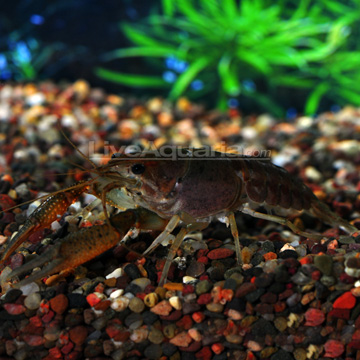 Scavengers such as
Red Lobsters play a very important role in creating a balanced ecosystem. They feed upon wastes before they are broken down by bacteria, which, in turn, helps control problematic nutrients and algae. Red Lobsters are extremely efficient scavengers that will also bring interesting behavior and variety to your freshwater aquarium or pond.
Scavengers such as
Red Lobsters play a very important role in creating a balanced ecosystem. They feed upon wastes before they are broken down by bacteria, which, in turn, helps control problematic nutrients and algae. Red Lobsters are extremely efficient scavengers that will also bring interesting behavior and variety to your freshwater aquarium or pond.
Freshwater aquariums and outdoor ponds are frequently plagued by excessive amounts of waste, debris, left-over food, and algae - all of which settle on substrate and decorations. The removal of this unsightly covering ultimately costs you time, energy, and resources better spent enjoying your water feature. Thankfully, common Red Lobsters offer a natural, efficient solution to keeping your aquarium or pond clean.
Red Lobsters (Procambarus sp.) are relatively small (only up to 5" long), and common throughout the waterways of North America. They are extremely hardy, and will winter successfully with only a few inches of substrate for burrowing and a partially frozen pond.
If you plan to keep more than one Red Lobster, you must provide adequate room, since Red Lobsters are instinctively territorial. Generally, 40 gallons of water per lobster is sufficient. Red Lobsters will also prey upon any fish that is both small and slow enough for it to catch. Fortunately,
koi and
goldfish larger than the lobster do not fit this description. However, exercise caution if you plan to breed koi within your pond; we recommend moving newly hatched fry to a separate rearing system.
| Interesting Facts: |
| Origin: |
North America. |
| Size: |
5 inches. |
| Diet: |
Omnivorous. |
| Tank Setup: |
Freshwater. A large amount of rocks, and a
substrate with a moderate grain size or finer for burrowing. Lobsters left in ponds can hibernate through the winter if the substrate is thick enough for them to bury themselves and a de-icer is used to keep the oxygen exchange. |
| Tank Conditions: |
33-85°F; pH 6.5-8.0; dH 3-10. |
| Min. Capacity: |
50 gallons. |
| Light: |
Natural Light. |
| Temperament: |
Semi-aggressive. |
| Swimming Level: |
Bottom. |
| Care Level: |
Easy. |
| Reproduction: |
Egg Layer. |
|
|